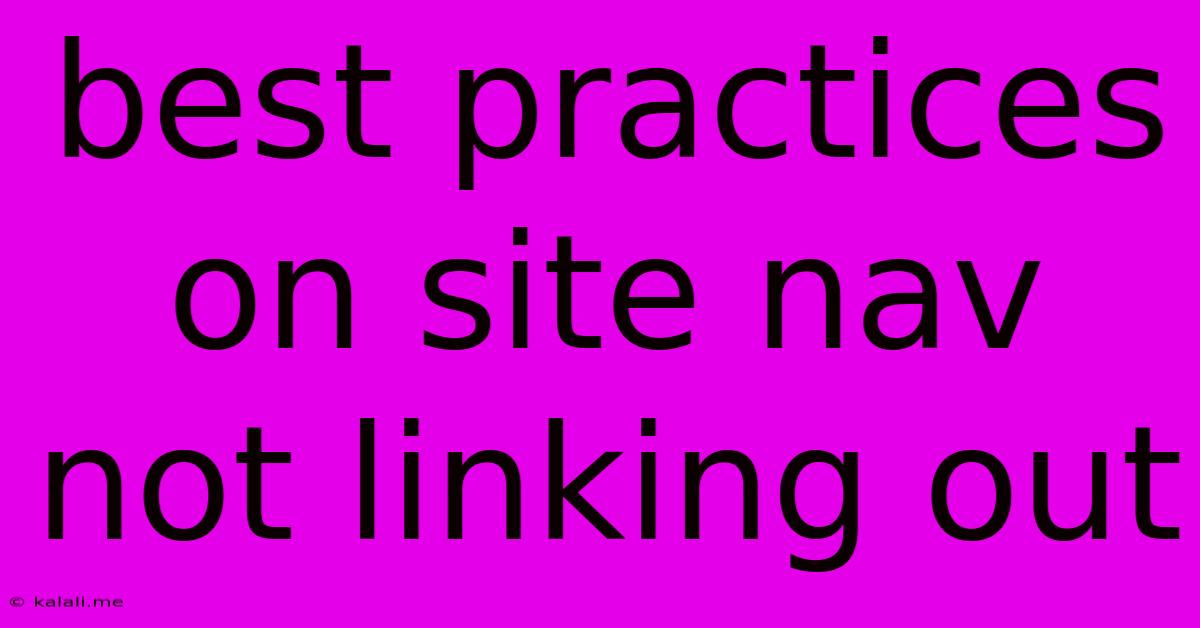Best Practices On Site Nav Not Linking Out
Kalali
May 30, 2025 · 3 min read

Table of Contents
Best Practices for On-Site Navigation That Doesn't Link Out
Meta Description: Learn how to create effective on-site navigation that keeps users engaged on your website, boosting user experience and SEO. Discover best practices for internal linking and avoiding unnecessary outbound links in your navigation.
Website navigation is crucial for user experience (UX) and SEO. A well-structured navigation system guides visitors effortlessly through your content, increasing engagement and reducing bounce rates. However, poorly designed navigation can send users straight to your competitors. This article focuses on best practices for on-site navigation, specifically emphasizing how to keep those links internal, strengthening your site's authority and improving SEO.
Why Avoid Outbound Links in Main Navigation?
Outbound links in your primary navigation menu can be detrimental to your website's performance for several reasons:
- Diluted User Experience: Users expect your main navigation to lead them to content on your site. Linking out directly from the navigation bar can be confusing and frustrating, disrupting their journey and potentially causing them to leave.
- Lost SEO Juice: Internal links are vital for SEO. They distribute "link juice," helping search engines understand the hierarchy and relevance of your pages. Sending that juice to external websites weakens your own site's authority.
- Brand Consistency Issues: Including external links in your primary navigation can weaken your brand identity and dilute your messaging. It suggests you are not entirely confident in the content on your own site.
Best Practices for Internal Navigation:
- Clear and Concise Labels: Use descriptive and user-friendly language for your navigation labels. Avoid jargon or overly technical terms. Think about what your target audience would search for.
- Logical Hierarchy: Organize your navigation menu in a logical and intuitive way, reflecting the structure of your website's content. A hierarchical structure, where main categories lead to subcategories, makes it easy for users to find what they need.
- Strategic Internal Linking: Carefully plan your internal links. Ensure each page is linked to relevant pages within your website. This enhances both user experience and SEO. Focus on building a strong internal link structure to improve site architecture.
- Breadcrumbs: Implement breadcrumbs to show users their location within your website's hierarchy. This helps with orientation and allows for easy navigation back to higher-level pages.
- Mega Menus: For websites with extensive content, consider using mega menus to display a large number of links in an organized and visually appealing way. This is particularly useful for eCommerce sites or blogs with many categories.
- Regular Audits: Periodically review and update your navigation menu to ensure it remains relevant and effective. Remove outdated or irrelevant links and adjust the structure as your website evolves.
- Mobile Optimization: Ensure your navigation is responsive and works seamlessly across all devices, including desktops, tablets, and smartphones. Navigation should be easily accessible and intuitive on all screen sizes.
- Visual Hierarchy: Use visual cues such as font size, color, and spacing to create a clear visual hierarchy within your navigation menu. This helps users quickly scan and identify important links.
- Accessibility: Adhere to accessibility guidelines to ensure your navigation is usable by people with disabilities. Use proper semantic HTML, provide sufficient color contrast, and add alternative text to images.
Exceptions: When Outbound Links Might Be Acceptable
There might be rare exceptions where an outbound link in your navigation is justifiable:
- Strategic Partnerships: If you have a strong partnership with another company and it enhances the user experience, a link might be considered.
- Essential Tools: A link to a login portal for a crucial tool your users need access to.
However, even in these cases, carefully consider if a more subtle approach—like a link in the footer—would be more appropriate.
By following these best practices, you can create a website navigation system that's both user-friendly and SEO-friendly, maximizing engagement and driving organic traffic to your site. Remember, a strong internal link structure is key to a successful website.
Latest Posts
Latest Posts
-
Got New Tires And Car Shakes
Jun 01, 2025
-
Stranger Things Season 2 Dvd Release
Jun 01, 2025
-
Owl Coin Fear The Walking Dead
Jun 01, 2025
-
How To Clean A Spa Tub
Jun 01, 2025
-
Launch Debian 12 Graphical Desktop Environments From Command Line
Jun 01, 2025
Related Post
Thank you for visiting our website which covers about Best Practices On Site Nav Not Linking Out . We hope the information provided has been useful to you. Feel free to contact us if you have any questions or need further assistance. See you next time and don't miss to bookmark.